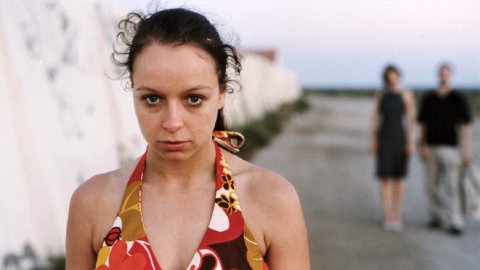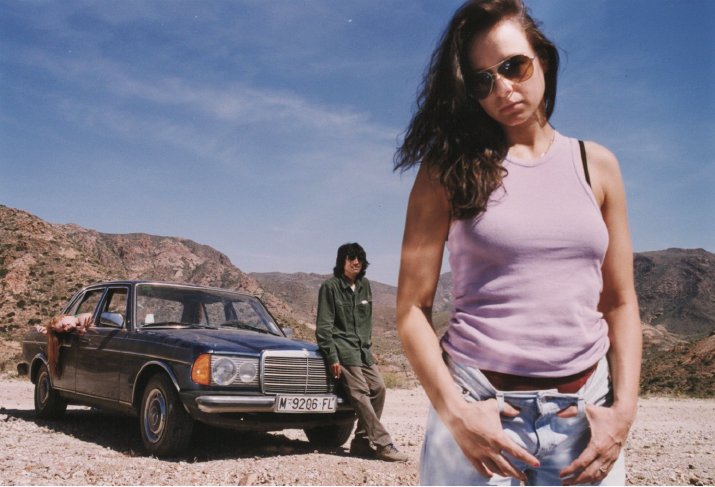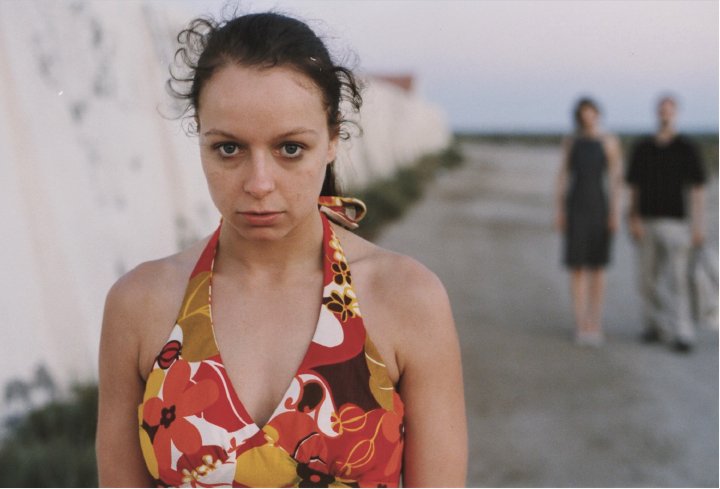
Film on Film: Morvern Callar revisited
Posted on Wed 26 July 2023
20th Century Flicks' Daisy Steinhardt takes us through Lynne Ramsay’s Movern Callar (2002), which is being screened from a new BFI 35mm print as part of Cinema Rediscovered 2023.
SPOILER ALERT! This article discusses Morvern Callar in-depth and includes spoilers.
Morvern Callar (Samantha Morton) is drifting, yet stuck. Muted. She lives in a grimy, desolate town. Her surroundings are dimly lit. Everything is grey. Even socialising, party drugs, and holidays raise only distant laughter. From a narrative perspective, nothing makes sense. So much happens, yet so little changes.
The film opens with extreme close ups. Only the ear and neck of the person lying next to her are visible. It is so silent that you cannot hear breathing. She rubs her face on the other person’s neck, and touches what looks like broken skin. The title card flashes up, after which the young woman, Morvern Callar, is shown lying on the floor. The source of the flashing light - a small Christmas tree - is revealed, as is the other body: a man on the ground a few feet away from a pool of blood. A note, titled “Read Me”, shows on the screen of a computer in the same room. The dead man - Morvern’s boyfriend - has left her with the money for a funeral, a mixtape, and a finished manuscript.
Morvern does not seem to quite register his death. She leaves his body in her flat for days on end before cutting it up and burying it. For reasons that never quite become clear, she claims his novel as her own.
It would be easy to take this film as an exploration of the dissociative nature of grief if its relentlessly dim lighting, gloomy atmosphere and dusty mise-en-scene did not create the unshakeable feeling that this stasis long predates Morvern’s boyfriend’s death.
The film’s IMDb Plot Keywords list the following: Christmas, Ibiza, grief, suicide, two women in bath tub, female rear nudity, breasts, plagiarised book, cleavage, male nudity, male frontal nudity, friendship, festival, drunkenness, the list goes on. Beyond providing an unashamedly horny form of search engine optimisation, many of these terms have little relevance to the film, but together they do unintentionally reflect Morvern Callar’s atmosphere of bleak disjointedness. Even a holiday to Spain is just a warmer version of the same unwelcoming monotony. It’s the same crapness everywhere, so stop dreaming. But Morvern does dream. I think.

I first saw Morvern Callar on a laptop a couple of years ago, staying with a friend in Glasgow. I was having a fairly intense period of anxiety at the time, and the film did not do wonders for my state of mind. But I remember absolutely loving it.
Rewatching it more recently, and finding myself presented with an hour and a half of a young woman not knowing what she was doing with her life, was less pleasant than I remembered. I had, as I often do, mistaken being very taken with a film for actually enjoying the experience of watching it.
Morvern is at a weird in-between stage. She lives in her own flat yet hasn’t entirely shaken off all of the hallmarks of childhood. She appears superficially content running around with her best friend Lanna. Despite the ‘lesbian subtext’ IMDb keyword further down the list, the two bathing together and sharing a bed has a bittersweet innocence to it. Similarly, Lanna revealing that she had slept with Morvern’s boyfriend, quickly followed by the two going on holiday together, is reminiscent of childhood friendships where you are not friends and then you are and it is that straightforward.

Despite Morvern Callar’s oppressive gloom, brightness does occasionally pop up. One of the things that stuck with me most from my first viewing was the soundtrack. It’s a very cool mix of Aphex Twin, Nancy Sinatra, The Velvet Underground and others, some of whom I am not cool enough to have previously known. Heard almost entirely diegetically through Morvern’s portable cassette player and earphones, it jars almost comically with her monotonous surroundings (“Some Velvet Morning” in the supermarket, for example) but her listening is often interrupted by someone from the real world wanting her attention.
One of the few moments where the grey temporarily subsides comes roughly halfway through the film when Morvern is burying her dismembered boyfriend in the mountains. For the first time, her surroundings are generally bright; grey clouds linger but the sky is blue and she wears a bright red hat. Birds sing, and she dances, looking, if not happy, then at least alive. Maybe she feels closer to her dead boyfriend and the life they had. Maybe she’s glad to be somewhere beautiful. Maybe she just wants to dance.
It’s easy to tie yourself in knots looking for the ‘why’ in Morvern Callar. But perhaps it’s best to follow the advice of Morvern’s dead boyfriend, who writes in his suicide note: “don’t try to understand it, it just felt like the right thing to do.”
With thanks to Mark Bould.